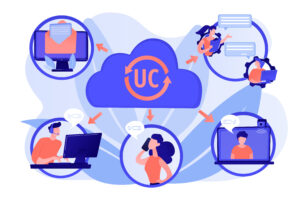One of the most prevalent and pressing issues of the business world across all sectors today is the difficulty in retaining and hiring qualified employees, and current unemployment stats only scratch the surface for the day-to-day impact on what this looks like within any given company or industry. According to current research, this issue does not seem to be improving anytime soon, with 83% of study participants revealing that they expect to have difficulty attracting employees this year.

As business leaders focused on fostering efficiency and productivity, leveraging and building the talents of those within our companies, and actively pushing back at the steep costs (not just financial) that come with a lack of qualified personnel, we must pay close attention to ensuring that we are doing all that can be done to retain and hire excellence. That includes seeking simplified seamless ways for potential and current employees to interact in a work-from-home setting or within the office, in particular by investing in UCaaS.
People have colloquially nicknamed the current climate of unemployment “The Great Resignation” due to its profound impact. Safety restrictions led to layoffs and reduced profits in some industries. Parents struggled to balance work and parenting when suddenly caring for their children full-time. As a result, they either reduced their active hours or quit their jobs entirely. Some employees in industries like healthcare, hospitality, manufacturing, and security felt unsafe. They decided to take a leave of absence as working from home was not an option. Others left because increasing mandates made them feel vulnerable or unable to continue to work for personal or health-related reasons.
In April 2020 alone, more than 4 million workers quit their jobs, according to the Job Openings and Labor Turnover Summary. Companies without proper technology faced sudden wake-up calls to continue daily processes efficiently.
With significant volatility in the stock market, the housing market, and the job market, it is vital to consider how we may set the stage to reduce and eliminate any hurdles that would prevent bringing on new and retaining existing talent. The cost of hiring a base-level employee in 2017 was $4425 and close to $15,000 for executive-level positions, not to mention the cost of productivity and lost days. Before any of the complications of a global pandemic, the time it took to replace an employee could take up to 94 days for highly skilled workers. Efforts that would otherwise be directed to fostering forward motion are spent backfilling on the hiring process, which within the technology sector includes an average of 14 calls and interviews, and that does not count the cancellations and no-shows, nor the time put into advertisements, background checks, and skill assessments.
With all of this in mind, successful companies have considered all areas to create a way to not only retain excellent employees but to stand head and shoulders above the rest to attract peak talent for their organizations. One such strategy is to effectively employ UCaaS.
Onboarding a new hire is time-consuming, hindering productivity. Long-term employees help new hires learn procedures. Fewer UIs simplify the transition process, allowing new hires to learn all resources in one place.
The strategy around UI consolidation is a delicate one. Most, if not all, UCaaS providers include internal chat, SMS, meetings, email, and calendar integrations alongside their core voice competencies. To rival that, the leading meeting and collaboration providers have enabled phone system functionality within their software. Technology’s evolution blurs collaboration and voice, creating a dilemma of redundant features and cluttered apps. Some UCaaS providers have attempted to win the interface challenge by promoting themselves as an all-inclusive replacement for existing tools. The problem with that approach is, they are starting from scratch regarding user adoption. Additionally, those existing tools don’t tend to go away completely, creating confusion and departmental silos. While collaboration tools have been integrated with telephony, bringing voice expertise in-house requires infrastructure and support changes.
To solve this problem, integrate external voice capabilities into the communication tools used by employees. Of course, this strategy differs based on which applications are currently in use. The playing field is broken into two categories: those that have a focus on voice in-house, and those that rely on external Public Switch Telephone Network (PSTN) and UCaaS providers to plug in behind their interface. As you may assume, the latter provides more competitive diversity as well as an additional layer of redundancy.
Besides the simplification for new hires resulting in a more efficient and faster onboarding process, UCaaS allows for remote work. A company can expand its hiring pool by offering remote work, leading to more qualified potential employees. Geographical limitations won’t be a problem.
With this added flexibility, come new security risks. As employees continue to connect to their corporate offices from anywhere, endpoint security and management are critical. Zero Trust is becoming mandatory for many industries; Single Sign-On (SSO) and Multi-Factor Authentication (MFA) are essential to companies. Consolidating voice into existing apps streamlines security management by consolidating network access points.
Skilled employees want to work remotely. Companies offering remote work attract better employees, reduce hiring costs, and increase productivity.
Renodis specializes in helping you to find exactly what you need while leveraging as many benefits as possible. Our expertise is connecting you with the communications technology that makes the most sense for your unique needs. Contact us for professional services that will provide the best solution to your needs.





